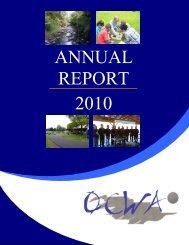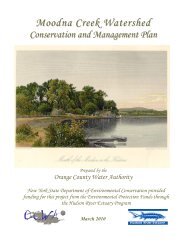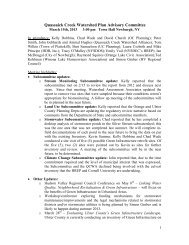Biodiversity of the Moodna Creek Watershed - Orange County Water ...
Biodiversity of the Moodna Creek Watershed - Orange County Water ...
Biodiversity of the Moodna Creek Watershed - Orange County Water ...
Create successful ePaper yourself
Turn your PDF publications into a flip-book with our unique Google optimized e-Paper software.
<strong>Moodna</strong> <strong>Biodiversity</strong><br />
L. Heady, 19 June 2008 DRAFT<br />
in stream corridors than in o<strong>the</strong>r portions <strong>of</strong> <strong>the</strong> landscape and bird diversity increases as <strong>the</strong><br />
width <strong>of</strong> stream corridors increase.<br />
Bats<br />
An abundance <strong>of</strong> insects and forest openings make stream corridors prime foraging habitat for<br />
bats. Large trees with peeling bark, such as shagbark hickories and dead standing snags are used<br />
as maternity colonies or summer roosting sites for bats. In addition to foraging and roosting, bats<br />
use stream corridors as travel routes. Bats that might be seen in stream corridors <strong>of</strong> <strong>the</strong> <strong>Moodna</strong><br />
<strong>Creek</strong> and tributaries include <strong>the</strong> big brown bat, little brown bat, and <strong>the</strong> rare Eastern smallfooted<br />
bat (NYS Special Concern). The Eastern small-footed bat has been observed in <strong>the</strong><br />
Mineral Spring Brook and Trout Brook stream corridors. The watershed and its stream corridors<br />
are also home to <strong>the</strong> federally endangered Indiana bat (NYS Endangered).<br />
Amphibians and Reptiles<br />
Several turtle, frog, and salamander species rely heavily on stream corridor habitats. The wood<br />
turtle is particularly interesting, not just because its angular shell looks like a wood carving, but<br />
also because <strong>the</strong> wood turtle spends its entire life in stream corridors. Wood turtle populations<br />
are found in stream corridors <strong>of</strong> <strong>the</strong> Otter Kill, Seely Brook and Woodbury <strong>Creek</strong>.<br />
Stream salamanders are lungless and must obtain oxygen through <strong>the</strong>ir skin. As a result, <strong>the</strong>y can<br />
be found in <strong>the</strong> moist areas <strong>of</strong> streambanks, seepages, and both intermittent and perennial<br />
streams. The most abundant headwater stream salamander in <strong>the</strong> Hudson Valley region is <strong>the</strong><br />
nor<strong>the</strong>rn two-lined salamander followed by <strong>the</strong> nor<strong>the</strong>rn dusky salamander. The longtail<br />
salamander is rare in <strong>Orange</strong> <strong>County</strong> and declining within New York State.<br />
Fish<br />
Fish communities <strong>of</strong> <strong>the</strong> <strong>Moodna</strong> <strong>Creek</strong> range from anadramous fishes that use <strong>the</strong> tidal creek<br />
and mouth for spawning, to inland warmwater and coldwater fish communities. Little<br />
comprehensive monitoring <strong>of</strong> <strong>the</strong> <strong>Moodna</strong> <strong>Creek</strong> fish community has been conducted. The<br />
historical warmwater fish community includes <strong>the</strong> following species: white sucker, creek<br />
chubsucker, rock bass, redbreast sunfish, pumpkinseed, black crappie, blueback shad, American<br />
shad, cutlips minnow, Eastern silvery minnow, golden shiner, bridle shiner, common shiner,<br />
spotfin shiner, spottail shiner, fallfish, longnose dace, blacknose dace, creek chub, redfin<br />
pickerel, chain pickerel, brown bullhead, fourspine stickleback, and tessellated darter (NYS<br />
Museum 1936). Of <strong>the</strong>se, <strong>the</strong> creek chubsucker, Eastern silvery minnow, bridle shiner, spottail<br />
shiner, spotfin shiner, fallfish, and fourspine stickleback have not been observed in recent times<br />
(NYSDEC Bureau <strong>of</strong> Fisheries 2007). However, additional surveys would be needed to confirm<br />
<strong>the</strong> presence or absence <strong>of</strong> <strong>the</strong>se species.<br />
Coldwater fishes <strong>of</strong> <strong>the</strong> <strong>Moodna</strong> <strong>Creek</strong> <strong><strong>Water</strong>shed</strong> include <strong>the</strong> native brook trout, and <strong>the</strong> stocked<br />
rainbow trout and brown trout. Stream reaches supporting coldwater fishes, invertebrates, and<br />
salamanders are usually fed by cold-cool groundwater. Brook trout and slimy sculpin are <strong>the</strong><br />
dominate fish <strong>of</strong> small coldwater streams <strong>of</strong> high quality. These streams have shallow margins,<br />
woody debris, canopy shading, and boulders. Blacknose dace, creek chub, and white sucker<br />
might also occur at coldwater sites. Both brook and brown trout are found in <strong>the</strong> Trout Brook and<br />
Woodbury <strong>Creek</strong> tributaries. The DEC annually stocks <strong>the</strong> <strong>Moodna</strong> <strong>Creek</strong> mainstem with brown<br />
and rainbow trout and <strong>the</strong> Woodbury <strong>Creek</strong> with brown trout.<br />
9











